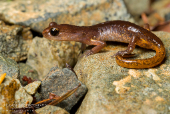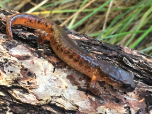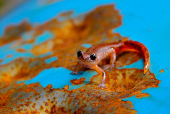 |
Painted Ensatina Range Map
|
|
|
 |
 |
 |
 |
 |
 |
 |
Painted Ensatina Juvenile

|
|
|
 |
 |
 |
 |
 |
 |
|
Painted Ensatina (Ensatina eschscholtzii picta)
Description: An adult Ensatina measures from 1.5 to 3.2 inches long from snout to vent, and 3 to 6 inches in total length. The Painted Ensatina subspecies is smaller than other Ensatina subspecies - averaging about 2/3 their size. A medium-sized salamander. The legs are long, and the body is relatively short, with 12 to 13 costal grooves. Nasolabial grooves are present. The tail is rounded and constricted at the base, which will differentiate this salamander from its neighbors. This subspecies is dark tan to brown above, with dark blotching along the upper sides, and yellow to orange blotching on the lower sides. The underside is pale orange or pinkish and the tail is mottled with black and yellow. A typical Ensatina of this subspecies has a "painted" pattern of dark and yellow to orange blotching on the back and sides, but as you can see in the pictures above, some individuals are very dark and show little or no pattern.) Males have longer, more slender tails than females, and a shorter snout with an enlarged upper lip, while the bodies of females are usually shorter and fatter than the bodies of males.
Habitat: Inhabits moist shaded evergreen and deciduous forests. Found under rocks, logs, other debris, especially bark that has peeled off and fallen alongside logs and trees. Most common where there is a lot of coarse woody debris on the forest foor. In dry or very cold weather, stays inside moist logs, animal burrows, under roots, woodrat nests, under rocks.
Range: The Painted Ensatina subspecies occurs in a small range along the Pacific coast from extreme northwest California in Del Norte County, to extreme southwest Oregon in Curry County.
Found in these States:
CA |
OR
Diet: Ensatinas eat a wide variety of invertebrates, including worms, ants, beetles, spiders, scorpions, centipedes, millipedes, sow bugs, and snails.
They expell a relatively long sticky tongue from the mouth to capture the prey and pull it back into the mouth where it is crushed and killed, then swallowed.
Typically feeding is done using sit-and-wait ambush tactics, but sometimes Ensatinas will slowly stalk their prey.
Reproduction: Reproduction is terrestrial. Mating takes place in Fall and Spring, but may also occur throughout the winter. Stebbins describes an elaborate Ensatina courtship involving the male rubbing his body and head against the female eventually dropping a sperm capsule onto the ground which the female picks up with her cloaca. The female can store the sperm until she determines the time is right to fertilize her eggs. At the end of the rainy season, typically April or May, females retreat to their aestivation site under bark, in rotting logs, or in underground animal burrows, and lay their eggs. Females lay 3 to 25 eggs, with 9 to 16 being average. Females remain with the eggs to guard them until they hatch. Young develop completely in the egg and probably leave the nesting site with the first saturating Fall rains, or, at higher elevations, after the snow melts.
»» Kingdom: Animalia - Animals
»» Phylum: Chordata - Chordates
»» Subphylum: Vertebrata - Vertebrates
»» Class: Amphibia - (Amphibians)
»» Order: Caudata - Salamanders
»» Family: Plethodontidae - Lungless Salamanders
»» Genus: Ensatina
»» Species: Ensatina eschscholtzii - Ensatinas
»» Subspecies: Ensatina eschscholtzii picta - Painted Ensatina
This article uses material from the Wikipedia article "Ensatinas", which is released under the Creative Commons Attribution-Share-Alike License 3.0. Content may have been omitted from the original, but no content has been changed or extended.
|
|













